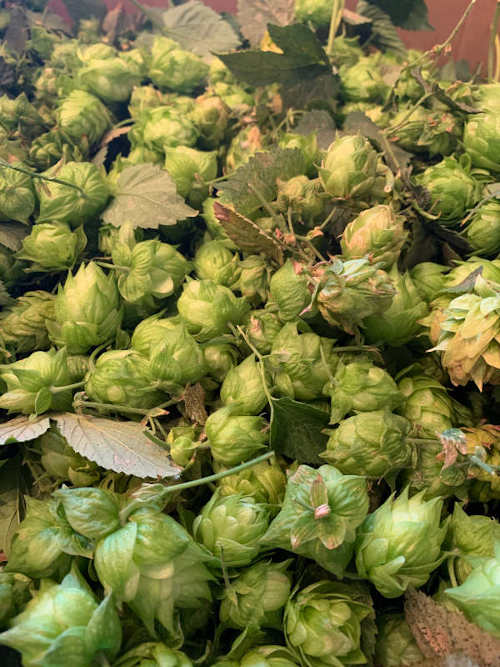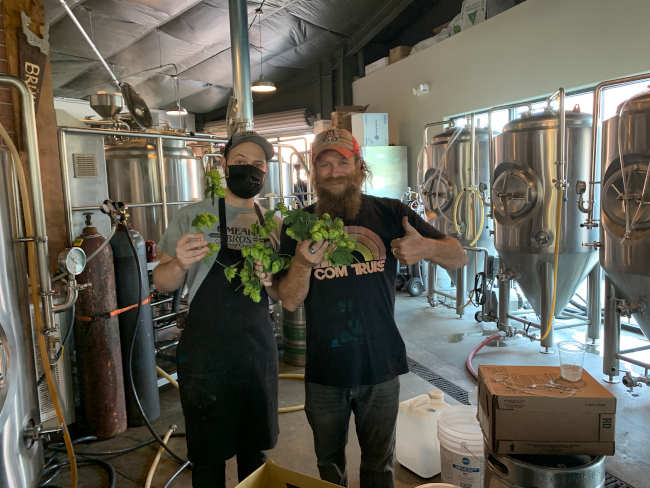- ESTHER OERTEL
- Posted On
Mensam Mundum — World Table: Growing hops in Lake County

LAKE COUNTY, Calif. — The Scotts Valley area of Lake County was once awash in hops, so much so that a rise in the earth on 11th Street at Scotts Valley Road was known colloquially as “Brewery Hill.”
Though the days of commercial hops cultivation in Lake County have fallen by the wayside, a Lake County farmer is doing his part to bring back the aromatic glory of that era.
Alex Vollelunga of Valley Long Farms in Lakeport has been growing hops on his property for the last four years. Vollelunga inherited the farm with its organic walnut orchard from his grandfather and has since expanded its offerings to encompass an extensive list of crops, including six varieties of hops.
Hops is integral to brewing beer and is one of the four main ingredients used to produce the quaff. The other three are malt, yeast and, of course, water.
It is the cone-shaped flowers of the hop plant that are used in the brewing process. Hidden inside each cone are tiny yellow pods, sticky glands called lupulin, which produce the resin that provides the characteristic bitterness that lends its aroma and flavor to beer.
This bitterness helps balance the sweetness of the malt. In addition, brewers can selectively use hops to produce a wide range of flavors within their created brews.
Much like wine grapes, each variety of hops has unique characteristics and can contribute wide-ranging flavor profiles such as citrus, pine, mango, resin, melon, and even the herbaceous notes of freshly cut grass.
Vegetal ingredients other than hops can also produce bitterness and flavor, and beer brewed using these rather than hops is known as “gruit.” A wide variety of plants can be used in gruit, including orange rind, spruce tips, juniper, yarrow, and bog myrtle.
This year Vollelunga’s hop bines (as the long hop stems are called) produced beyond his home brewing needs, so he offered some to Lakeport’s O’Meara Brothers Brewing Co. for use in their beer production.
According to brew master Tim O’Meara, the three varieties from Vollelunga — Cascade, Chinook, and Willamette — were “fantastic, very fresh and aromatic.”
“The beer came out great, with aromas of grapefruit and pineapple, as well as some herbaceous grassy notes. We are very grateful,” said O’Meara.
The beer created by O’Meara using these local hops was dubbed Hydrilla Killa and is a double India pale ale, or DIPA.
When brewed in the fall using fresh hops, beer is considered “wet hopped.” At other times of year when fresh hops aren’t available, brewers use the “dry hopped” method with processed hop pellets.
According to O’Meara, the fresh, whole cone hops were steeped in a large sack during the pre-fermentation wort boil to make a sort of hops tea. The wort boil is done to ensure that any harmful bacteria are eliminated from the brew.

In addition to imparting flavor, hops have inherent preservative qualities, extending the life of beer. The acids within hop resin are naturally antimicrobial, helping to ward off spoiling bacteria during fermentation, as well as keeping it fresher longer once brewed.
Beer brewers in times past understood this. By the late 1700s, British brewers were adding extra hops when beer was being exported to faraway places, averting spoilage on long ocean voyages or overland expeditions.
Another plus is that hops help to retain beer’s head of foam, a key component of its aroma and flavor.
The hop plant, Humulus lupulus, is a hardy climbing perennial in the Cannabinaceae family, which also includes hemp and marijuana. Despite its near relative, smoking or otherwise imbibing hops will not produce a high.
As mentioned above, the long arms of the hop plant are known as bines, rather than vines. Botanically speaking, vines climb using tendrils or suckers, while bines grow in a helix around a support.
Vollelunga has cleverly interplanted hops among his walnut trees so the bines can use the trunks as supportive trellises. His hops are harvested in August and September when the cones have started turning from green to crisp brown, prior to the walnut harvest in October and November.
Vollelunga plans to expand the number of hops bines every year, with the goal of being able to supply Lake County breweries with fresh hops during the “wet hop” brewing season. They currently have more than 20 bines and will plant more next spring.
In addition to crop cultivation, Vollelunga makes oils for culinary and grooming purposes from his farmed walnuts under the name The Bearded Nut. To reach him about hops or any of the Valley Long Farms products, he may be contacted at This email address is being protected from spambots. You need JavaScript enabled to view it. or This email address is being protected from spambots. You need JavaScript enabled to view it..
There is more to hops than beer.
Hops are utilized in herbal medicine in a similar way to valerian, as a treatment for restlessness, insomnia or anxiety. A pillow filled with hops was a common folk remedy for sleeplessness, and studies with animals have shown hops to have sedative qualities.
And while not a kitchen staple, hops may be incorporated into foods to add a touch of bitterness, such as in a marinade or pesto, or as a sprinkled seasoning.
Depending on the variety, hops will add a floral, earthy, peppery, or citrus flavor to dishes. Without a light hand, however, the bitterness can be overpowering.
The flowers, or cones, of the plant are most widely used in cuisine, but several other parts of the plant are edible, including the young shoots, which can be treated like asparagus.
Salt flavored with hops can be made with either processed pellets or fresh hops cones. Pellets may be ground and combined with salt using a ratio of one teaspoon ground hops to one tablespoon of salt, or a few fresh hops cones may be covered with salt in a closed container to impart a hoppy flavor.
Hops is used in some products because of its inherent aromatherapeutic properties, like lip balm and soap, or in herbal teas.
Today’s recipe for beer bread is reprinted from my March 2020 column on local craft beer breweries and includes several variations. To expand on the theme, try using an exceptionally hops-forward beer in the bread.
I’ll leave you with a “hoppy” (and perhaps happy) poem from Thomas Tusser’s 1557 work, “Five Hundred Points of Good Husbandry.”
"The hop for his profit I thus do exalt,
It strengtheneth drink and it flavoureth malt;
And being well-brewed long kept it will last,
And drawing abide, if ye draw not too fast."
Beer Bread with Rosemary and Olives
3 cups unbleached white flour
3 tablespoons sugar
1 tablespoon baking powder
1 teaspoon salt
2 teaspoons fresh rosemary, minced
½ cup roughly chopped pitted kalamata olives
12 ounces (1 ½ cups) good quality beer
4 tablespoons extra virgin olive oil, divided
Preheat oven to 350 degrees and grease a 13 x 9 x 2 baking dish with one tablespoon of the olive oil.
Stir together the flour, sugar, salt and baking powder in a medium bowl. Stir in the rosemary, then the chopped olives until both are well distributed.
Pour in the beer and stir until just incorporated into the mix. The dough will be sticky and somewhat heavy.
Spoon the dough into the baking pan and spread evenly. Drizzle the remaining olive oil over the top.
Bake for 20 to 25 minutes or until the top is golden brown. Transfer bread to a trivet or cooling rack.
Cut into rectangles and serve warm.
Variations:
Eliminate olives and add ½ cup shredded sharp cheddar cheese.
Diced apple (from one medium peeled apple) can be added along with the cheese.
Go crazy with the olives and add several different types, up to 1 ½ cup total.
Substitute honey for the sugar.
Substitute half the white flour for whole wheat.
Use melted butter instead of olive oil.
Increase or decrease the sugar or honey. (Anywhere from one to four tablespoons will work.)
Increase or decrease rosemary to taste.
Add an equal amount of fresh thyme along with the rosemary.
Add a couple tablespoons chopped scallions or chives to any of the variations or on their own.
Add ¼ cup chopped sun-dried tomatoes to the olives and rosemary.
Esther Oertel is a writer and passionate home cook from a family of chefs. She grew up in a restaurant, where she began creating recipes from a young age. She’s taught culinary classes in a variety of venues in Lake County and previously wrote “The Veggie Girl” column for Lake County News. Most recently she’s taught culinary classes at Sur La Table in Santa Rosa. She lives in Middletown, California.






































